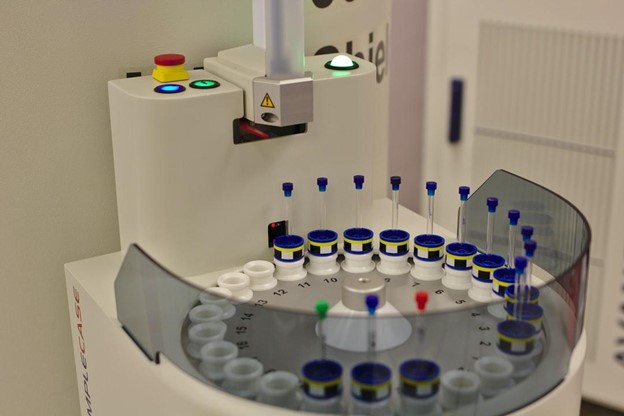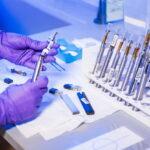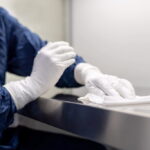Let’s dive into the fascinating world of lab vials!
These little containers might seem simple, but there’s more to them than meets the eye. Vials come in all shapes and sizes. Each is designed for specific experiments and substances.
From the common screw-top vial to the sophisticated lyophilization vial, each type has a story to tell. Let’s unravel the mystery behind these microscopic marvels. We will reveal how they make science happen!
Screw-Cap Vials
The Screw-Cap Vial is known for its ease of use and secure sealing feature. These vials are made of borosilicate glass or clear plastic. Each material caters to different experimental needs.
These are often the go-to choices for chromatography. This is because of their excellent thermal resistance and chemical compatibility.
Their reliable sealing mechanism prevents leakage and contamination. This makes them ideal for storing liquid and solid samples in lab experimentation.
Apart from chromatography, these vials’ applications span across the following:
– spectrophotometry
– cell culture
– microbial culture,
These are testifying to their versatility in the realm of scientific research.
Snap-Cap Vials
Snap-cap vials are another common type of lab vial, designed with a unique cap style that ‘snaps’ into place. This design provides an effective seal.
This is while still allowing the vials to be easily opened and closed. This makes them particularly handy for routine lab work.
These are made from glass or plastic. Snap-Cap Vials are often used in chromatography for their easy access and handling. They are particularly popular in DNA and RNA extraction processes.
This is due to the ability to retrieve small samples. This is without the risk of cross-contamination.
These vials are indispensable lab experimentation tools. This is with applications that reach far beyond the realm of chromatography. It highlights their utility and flexibility in various scientific endeavors.
Crimp-Top Vials
Crimp-top vials are among the most secure forms of lab vials. They are primarily used when a tight seal is paramount to the experiment’s success.
The cap uses a specialized tool that crimps or seals, the cap onto the vial. This ensures minimal risk of leakage or contamination.
These vials are employed in gas chromatography due to their airtight seals. These are crucial for maintaining the integrity of gas samples.
Made from glass, they are also resistant to thermal changes and chemical reactions. This makes them an essential lab experimentation tool.
Their vial applications are broad. They cover various laboratory processes including high-performance liquid chromatography (HPLC). It also includes other tasks requiring secure storage of samples.
Lyophilization Vials
Lyophilization Vials are for the process of freeze-drying. This is a method used to dehydrate fragile and heat-sensitive materials. This includes biological substances and pharmaceuticals.
These vials are specially engineered to withstand sub-zero temperatures. These also withstand the intense pressures of the lyophilization process. It preserves the integrity of the sample within.
These vials offer excellent thermal resistance and compatibility. This comes with a wide range of substances. Lyophilization Vials hold a unique place. This facilitates groundbreaking research and advancements in fields like:
– biotechnology
– medicine
– food technology
These vials are crucial for any experiment involving freeze-drying methodologies. This is when it comes to lab experimentation tools.
Autosampler Vials
These represent a key component in modern laboratory experimentation. This comes with a design tailored for automated sampling systems.
These vials are primarily used in chromatography. This is where precise and repeatable sampling is crucial.
Crafted from glass or plastic, these vials come with specific dimensions. This is to ensure compatibility with an array of autosampler devices. Their screw-cap, snap-cap, or crimp-top closures offer reliable sealing options.
These prevent sample contamination and leakage. This, thereby maintains the integrity of the sample for subsequent analysis.
These are a cornerstone in the field of automated laboratory testing. This is given their specific design and application. This contributes to efficiency and accuracy in scientific investigations.
Microsampling Vials
Microsampling Vials are experiments requiring small sample sizes. These vials are efficient in conserving precious samples in laboratory settings. These are often crafted from high-quality glass or plastic.
Their compact size makes them suitable for sensitive analyses like chromatography. This is where the accurate handling of minuscule sample volumes is vital.
Microsampling Vials have become instrumental in biomedical research, environmental testing, and forensic science. These allow scientists to conduct precise testing with limited sample volumes.
Shell Vials
Shell Vials are an essential lab tool. This is particularly designed for high-throughput screening and micro-volume sampling.
These vials permit easy access to the sample material. This makes them a preferred choice for microbiology, high-throughput screening, and cryogenic storage.
Shell Vials, made from glass or plastic, offer high chemical resistance. This makes them suitable for various types of chromatography. It is also suitable for other sensitive lab experiments.
These vials can store sufficient sample volumes for most applications. This is despite their compact size. This further broadens their utility in scientific research.
Dilution Vials
Dilution Vials play a crucial role in scientific labs. This is especially true in those processes where sample concentration needs to be accurately adjusted.
These vials are designed and used for diluting solutions or substances. This ensures precise and controlled reduction in sample concentration.
The vials are typically manufactured from glass or plastic. Both materials are known for their chemical resistance and durability.
They usually come with a screw-cap or snap-cap, providing a secure seal to avoid contamination and leakage. Notably, Dilution Vials are indispensable in the following:
- chemical analysis
- pharmaceutical testing
- microbiology
These underly their importance in the world of scientific research.
Explore The Different Types of Lab Vials
So, we’ve gone on a journey through the world of lab vials. Bet you didn’t know there were so many types, huh? Each one has its superpowers, from staying strong under extreme temperature changes to keeping tiny samples safe.
They’re all pretty amazing in their way. Whether it’s for checking out the teeny tiny details in a DNA sample or freeze-drying something for research, these vials are a scientist’s best friend.
So next time you walk past a lab or watch a cool science show, remember these little heroes helping us make big discoveries!
If you want to explore the best topics, we’ve got you covered. Check out some of our other blogs today!
Read Also
- Creative Approaches to Alleviating Healthcare Staff ShortagesHospitals and clinics are facing staff shortages, which makes it harder to take care of patients well. Finding simple and useful solutions is very important. Easy changes like flexible work hours, good training, and chances to grow can help staff stay happy. Technology, like online doctor visits and helpful tools, can make work easier. Smart… Read more: Creative Approaches to Alleviating Healthcare Staff Shortages
- Understanding the Role of Sterilizers in Healthcare FacilitiesHave you ever wondered how hospitals keep their equipment safe enough to use on dozens of patients every day? Most people never think about what happens behind the scenes, yet these hidden steps play a huge role in patient safety. Sterilizers are part of that system, working quietly to remove harmful germs before any instrument… Read more: Understanding the Role of Sterilizers in Healthcare Facilities
- Building Healthcare Access Where It’s Needed Most: A Local First ApproachHealthcare shouldn’t depend on where you live. But in the U.S., it often does. If you’re in a big city, you likely have options. If you’re in a small town or an underserved neighbourhood, it’s a different story. To fix this, more healthcare leaders are turning to a local-first approach. That means putting clinics and… Read more: Building Healthcare Access Where It’s Needed Most: A Local First Approach
- Revolutionizing Patient Engagement: Innovative Solutions for Improved Care and Treatment SuccessNavigating healthcare system can often feel overwhelming for patients. Between appointments, prescriptions, and treatment regimens, it’s easy for crucial details to get lost in the shuffle. That’s why effective patient engagement and support solutions are more important than ever. Companies like Serva Health, with their pharma hub services, are stepping up to ensure that patients… Read more: Revolutionizing Patient Engagement: Innovative Solutions for Improved Care and Treatment Success
- On-Demand Healthcare Staffing As A Cost-Saving StrategyThis is an exciting and challenging time for the healthcare industry. Technology is advancing almost faster than humans can keep pace. New legislation is creating fresh challenges for the future of healthcare, and the shifting population demographic continues to place more pressure on healthcare facilities. Amidst these changes, healthcare facilities are facing a critical staffing… Read more: On-Demand Healthcare Staffing As A Cost-Saving Strategy
- The Benefits of Contract Labor Staffing in HealthcareThe most successful healthcare facilities today aren’t just reacting to crises—they are building workforce resilience to withstand them. Unpredictable patient demand, coupled with persistent nursing shortages, has made the traditional staffing model obsolete. Relying on mandatory overtime to cover a sudden surge in capacity is a recipe for high turnover and rising employee burnout relief… Read more: The Benefits of Contract Labor Staffing in Healthcare
- Management Reinforcement for Healthcare Providers in a Shifting SystemHealthcare is changing faster than ever. So, providers are feeling the pressure to keep up. New technology, changing patient needs, and constant rule updates make it tough for managers to stay on top. Strong leadership helps teams work better, give great care, and stay happy in their jobs. Here’s how healthcare leaders can strengthen their… Read more: Management Reinforcement for Healthcare Providers in a Shifting System
- Why Effective Disinfection Remains the Foundation of Public HealthFrom hospitals and schools to transport hubs and food production sites, disinfection is central to breaking the chain of infection and protecting community health. The COVID-19 pandemic highlighted how crucial surface hygiene and environmental control are in reducing the spread of harmful microorganisms. Yet, beyond emergency response, routine and validated disinfection practices remain the cornerstone… Read more: Why Effective Disinfection Remains the Foundation of Public Health









